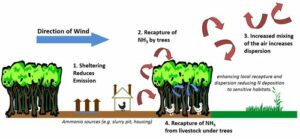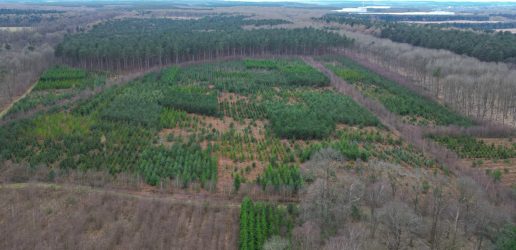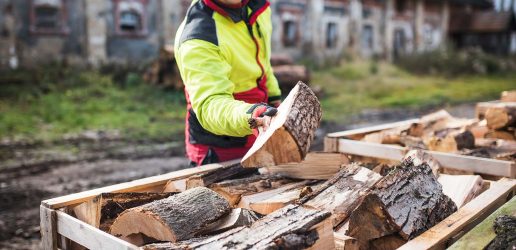A new calculator and planting guidance have been developed to help farmers decide which trees to plant, and in what formation, to mitigate the impact of ammonia emissions from animal housing and grazing areas.
The free, online tool and guidance are the result of a collaboration between Forest Research scientists and the Natural Environment Research Council’s Centre for Ecology & Hydrology (CEH), funded by the Scottish Environment Protection Agency (SEPA).
Agriculture is the main source of ammonia emissions in the UK, and animal housing units are responsible for around a quarter of the total ammonia produced by the industry.
Effects of ammonia
Locally, ammonia emissions can lead to excess nitrogen levels in sensitive habitats, which can in turn lead to a decline in the diversity of lichens, mosses and flora.
It can also lead to acidification of soils, create an unpleasant odour and combine with other pollutants to produce fine particulate matter pollution, which is harmful to human health.
Benefits of the new tool
The calculator is designed so farmers, regulators and planning authorities can maximise the benefits of planting tree shelterbelts for ammonia recapture. It provides an estimate of the percentage of ammonia that will be recaptured by the various planting options over different time spans.

Advice on the website covers which tree species will thrive in different parts of the UK and are suitable for the farm’s soil, what distance from animal housing to plant trees and in what configuration. There is information to help plan planting and management to complement existing woodland.
Dr Elena Vanguelova, a soil and forest biogeochemist expert from Forest Research said: “Tree shelters are an agroforestry technique that have benefits for farmers and society as a whole.
“The capture of carbon and nitrogen by additional planting will play a role in helping the UK achieve its greenhouse gas emission reduction targets.
“Our calculator and guidance provides farmers and landowners with the information they need to use nature’s best nitrogen mops to mitigate the ammonia produced by animal housing units while protecting the wider environment, such as soils and waters.
“The new tool can be used alongside our existing ESC decision-support software that helps guide forest managers and planners to select ecologically suited species to sites, instead of selecting a species and trying to modify the site to suit.”
The calculator is available online and is free to use: www.farmtreestoair.ceh.ac.uk
A full press release is available from CEH.
Recent News
View All news
Seventeen coniferous tree species show early promise for future commercial timber production in the UK
Researchers have set up a network of nine large scale experiments across the UK to test the suitability of 17 tree species as potential alternatives for future commercial timber production.
Forest Research are looking for people involved in the harvesting, processing, transport, import, or trade of firewood in Scotland to complete an important survey.

New guide to help local authorities conduct a people survey on the social value of their treescapes
A new step-by-step guide to help local authorities, charities and civic societies carry out a people survey to understand social and cultural values related to trees in their area, is now available.

Seventeen coniferous tree species show early promise for future commercial timber production in the UK
Researchers have set up a network of nine large scale experiments across the UK to test the suitability of 17 tree species as potential alternatives for future commercial timber production.
Forest Research are looking for people involved in the harvesting, processing, transport, import, or trade of firewood in Scotland to complete an important survey.

New guide to help local authorities conduct a people survey on the social value of their treescapes
A new step-by-step guide to help local authorities, charities and civic societies carry out a people survey to understand social and cultural values related to trees in their area, is now available.

